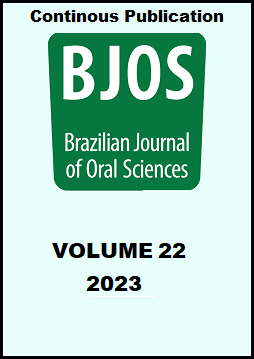Abstract
Phenylmethylsulfonyl fluoride (PMSF) is a protease inhibitor widely used in research, but fluoride is released during its action and this knowledge has been neglected in dental research. Aim: to evaluate if fluoride released by salivary protease action on PMSF affects enamel remineralization and fluoride uptake. Methods: Groups of 10 enamel slabs, with caries-like lesions and known surface hardness (SH), were subjected to one of the following treatment groups: Stimulated human saliva (SHS), negative control; SHS containing 1.0 μg F/mL (NaF), positive control; and SHS containing 10, 50 or 100 μM PMSF. The slabs were subjected to a pH-cycling regimen consisting of 22 h/day in each treatment solution and 2 h/day in a demineralizing solution. After 12 days, SH was again measured to calculate the percentage of surface hardness recovery (%SHR), followed by enamel fluoride uptake determination. The time-related fluoride release from 100.0 μM PMSF by SHS action was also determined. Data were analyzed by ANOVA followed by Newman-Keuls test. Results: The release of fluoride from PMSF by SHS was rapid, reaching a maximum value after 10 min. Fluoride released from PMSF was more effective in enhancing %SHR and increasing fluoride uptake in enamel compared with SHS alone (p < 0.05); furthermore, it was equivalent to the positive control (p > 0.05). Conclusion: In conclusion, fluoride released by saliva from PMSF is available to react with enamel and needs to be taken into account in research using this protease inhibitor.
References
Papale F, Santonocito S, Polizzi A, Giudice AL, Capodiferro S, Favia G, et al. The new era of salivaomics in dentistry: frontiers and facts in the early diagnosis and prevention of oral diseases and cancer. Metabolites. 2022 Jul;12(7):638. doi: 10.3390/metabo12070638.
Siqueira WL, Dawes C. The salivary proteome: challenges and perspectives. Proteomics Clin Appl. 2011 Dec;5(11-12):575-9. doi: 10.1002/prca.201100046.
Xiao H, Wong DT. Method development for proteome stabilization in human saliva. Anal Chim Acta. 2012 Apr;722:63-9. doi: 10.1016/j.aca.2012.02.017.
Fahrney DE, Gold AM. Sulfonyl Fluorides as Inhibitor of Esterases. I. Rates of Reaction with Acetylcholinesterase, α-Chymotrypsin, and Trypsin, J Am Chem Soc. 1963;85(7):997-1000. doi: 10.1021/ja00890a037.
Minaguchi K, Madapallimattam G, Bennick A. The presence and origin of phosphopeptides in human saliva. Biochem J. 1988 Feb;250(1):171-7. doi: 10.1042/bj2500171.
Nieuw Amerongen AV, Oderkerk CH, Driessen AA. Role of mucins from human whole saliva in the protection of tooth enamel against demineralization in vitro. Caries Res. 1987;21(4):297-309. doi: 10.1159/000261033.
Fisher SJ, Prakobphol A, Kajisa L, Murray PA. External radiolabelling of components of pellicle on human enamel and cementum. Arch Oral Biol. 1987;32(7):509-17. doi: 10.1016/s0003-9969(87)80013-4.
Koller MM, Maeda N, Purushotham KR, Scarpace PJ, Humphreys-Beher MG. A biochemical analysis of parotid and submandibular salivary gland function with age after simultaneous stimulation with pilocarpine and isoproterenol in female NIA Fischer 344 rats. Arch Oral Biol. 1992 Mar;37(3):219-30. doi: 10.1016/0003-9969(92)90092-m.
Steinberg D, Beeman D, Bowen WH. The effect of delmopinol on glucosyltransferase adsorbed on to saliva-coated hydroxyapatite. Arch Oral Biol. 1992 Jan;37(1):33-8. doi: 10.1016/0003-9969(92)90150-7.
Stinson MW, Haraszthy GG, Zhang XL, Levine MJ. Inhibition of Porphyromonas gingivalis adhesion to Streptococcus gordonii by human submandibular-sublingual saliva. Infect Immun. 1992 Jul;60(7):2598-604. doi: 10.1128/iai.60.7.2598-2604.1992.
Iontcheva I, Oppenheim FG, Troxler RF. Human salivary mucin MG1 selectively forms heterotypic complexes with amylase, proline-rich proteins, statherin, and histatins. J Dent Res. 1997 Mar;76(3):734-43. doi: 10.1177/00220345970760030501.
Bassim CW, Ambatipudi KS, Mays JW, Edwards DA, Swatkoski S, Fassil H, et al. Quantitative salivary proteomic differences in oral chronic graft-versus-host disease. J Clin Immunol. 2012 Dec;32(6):1390-9. doi: 10.1007/s10875-012-9738-4.
Rölla G, Melsen B. Desorption of protein and bacteria from hydroxyapatite by fluoride and monofluorophosphate. Caries Res. 1975;9(1):66-73. doi: 10.1159/000260144.
Hamilton IR. Biochemical effects of fluoride on oral bacteria. J Dent Res. 1990 Feb;69 Spec No:660-7; discussion 682-3. doi: 10.1177/00220345900690S128.
Bradshaw DJ, Marsh PD, Hodgson RJ, Visser JM. Effects of glucose and fluoride on competition and metabolism within in vitro dental bacterial communities and biofilms. Caries Res. 2002 Mar-Apr;36(2):81-6. doi: 10.1159/000057864.
Cury JA, Tenuta LM. Enamel remineralization: controlling the caries disease or treating early caries lesions? Braz Oral Res. 2009;23 Suppl 1:23-30. doi: 10.1590/s1806-83242009000500005.
Zero DT. In situ caries models. Adv Dent Res. 1995 Nov;9(3):214-30; discussion 231-4. doi: 10.1177/08959374950090030501.
White DJ. Reactivity of fluoride dentifrices with artificial caries. I. Effects on early lesions: F uptake, surface hardening and remineralization. Caries Res. 1987;21(2):126-40. doi: 10.1159/000261013.
Koo RH, Cury JA. Soluble calcium/SMFP dentifrice: effect on enamel fluoride uptake and remineralization. Am J Dent. 1998 Aug;11(4):173-6.
Fiske CM, Subarrow Y. The colorimetric determination of phosphorus. J Biol Chem. 1925 Dec;66(2):375-400.
Ayres M, Ayres M Jr, Ayres DL, Santos AS: BioEstat 2.0: Statistical Applications in Biological Sciences and Medicine. Belém: Sociedade Civil Mamiraua; 2000. Portuguese.
Feng Y, Li Q, Chen J, Yi P, Xu X, Fan Y, et al. Salivary protease spectrum biomarkers of oral cancer. Int J Oral Sci. 2019 Jan;11(1):7. doi: 10.1038/s41368-018-0032-z.
Shellis RP, Duckworth RM. Studies on the cariostatic mechanisms of fluoride. Int Dent J. 1994 Jun;44(3 Suppl 1):263-73.
Pearce EIF, Jenkins GN: The decomposition of monofluorophosphate by enzymes in whole human saliva. Arch Oral Biol 1977;22(6):405-7. doi: 10.1016/0003-9969(77)90064-4.
Bowen WH. Relative efficacy of sodium fluoride and sodium monofluorophosphate as anti-caries agents in dentifrices: Proceedings of a conference sponsored by Unilever Research, held at the Royal Society of Medicine, London, 5 November 1994. London: Royal Society of Medicine Press; 1995. 66p.
Tenuta LMA, Cury JA. Laboratory and human studies to estimate anticaries efficacy of fluoride toothpastes. Monogr Oral Sci. 2013;23:108-24. doi: 10.1159/000350479.

This work is licensed under a Creative Commons Attribution 4.0 International License.
Copyright (c) 2022 Paulo Edelvar Corrêa Peres, Jean Fu, Zero DT, Jaime Aparecido Cury


